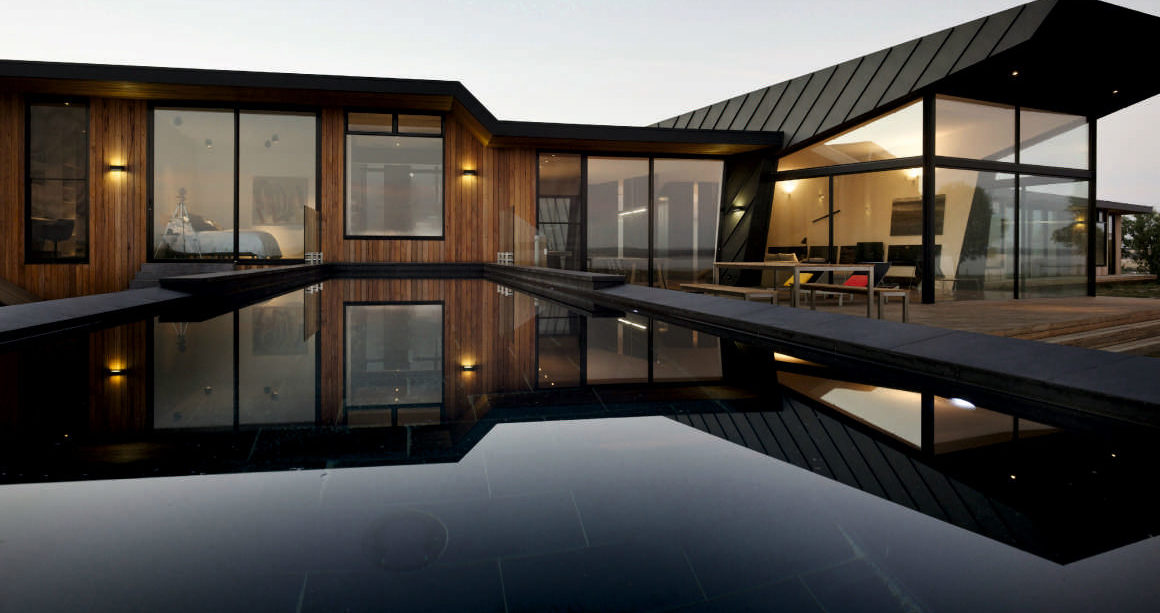The term contemporary architecture is applied to a range of styles of recently built structures and spaces which are optimised for current use.
The roof, covering of the top of a building has a big impact on the style of a building, serving to protect against rain, snow, sunlight, wind, and extremes of temperature, it significantly defines the appearance of a building. An architect uses a wide variety of roof forms to specifically create a certain volumetric appearance and use of space: flat, pitched, vaulted, domed, or a combination which are dictated by technical, economic, or aesthetic considerations.
The earliest roofs constructed by man were probably thatched roofs that were made of straw, leaves, branches, or reeds; they were usually set at a slope, thicker branches and timbers eventually came to be used to span a roof, with clay or some other relatively impermeable substance pressed into the interstices between them. Gabled and flat roofs were possible with these materials. With the invention of brick and cut stone for building, the basic roof forms of the dome and vault appeared. Two main types of roofs are flat roofs and sloping. The flat roof has historically been widely used in the Middle East, the American Southwest, and anywhere else where the climate is arid and the drainage of water off the roof is thus of secondary importance. Flat roofs came into widespread use in Europe and the Americas in the 19th century.
When “BAUHAUS” architects decided to “provoke” with cubistic architecture the flat roof became en vogue. New waterproof materials, the use of steel and concrete made them more practical. Flat roofs soon became the most common for warehouses, office buildings, commercial buildings and residential structures. Today flat roofs are very popular as they open up the possibility to use a flat roof as additional outdoor living space.
They can be used in many ways:
- Flat roofs offer great potential for large scale solar PV installations, as they are typically not shaded and get great sun exposure throughout the day. Solar panels or other technical equipment such as HVAC can be installed here.
- Covered with decking, a flat roof can provide a wonderful space for a roof garden and often with amazing views. Install some shading and a sun-lounger and enjoy the sunsets.
- Install a green-roof and use your roof as a rooftop garden with plants and flowers.
- Build a summer bedroom on your flat roof – Imagine how nice it is waking up to the sunrise on your roof. Install a temporary garden tent with mosquito curtains and enjoy the cool breezes of a hot summer night. Make sure the garden tent is properly fixed and of course provide security rails.
- Flat roofs provide additional space for sun terraces and even swimming pools.
- Grow a vegetable farm on your roof! Using the existing roof space, every inhabitant could have 5 m2 of rooftop space to grow his food. How wonderful would this change our view on food, waste and quality of food?
And now allow me to clear out some myths about flat roofs
MYTH 1: Flat Roofs Leak More.
Yes, they can leak; so can pitched roofs, hip roofs and shed roofs. However, when properly designed and installed, a flat roof will have as good as or better weathering characteristics than a pitched roof. A flat roof must be constructed much like a pool. It must be 100 percent waterproof. This takes the concerted efforts of multiple parties. It starts with the architect, whose job it is to design it correctly. You must be able to trace the path of a drop of water falling on the building down the exterior face, around the walls and roof planes and crevices, all without your pencil ever lifting up. In other words, water falling outside must stay outside.
Myth 2: Flat roofs can’t possibly support all the extra weight!
That’s a totally valid concern, but rest assured, your architect and engineer have this in mind when designing the roof structure. Certainly, the weight of plants and even a pool can add up, but your home must support a variety of loads: wind, seismic activity, building weight, furniture, occupants etc. All structures are required to be constructed to support local various load conditions regardless of the roof pitch.
Myth 3: Flat roofs are expensive.
Relative costs can be hard to quantify, but I would argue that flat roofs are materially more efficient than sloped roofs. This is for two reasons. First, you’re using fewer resources to construct the actual roof assembly. It takes quite a bit of material to construct a pitched roof: shingles or metal, rafters, ridge poles, insulation, bracing, collar ties etc. And second, flat roofs ensure that you’re heating and making use of all of the space you construct. Often space that’s above the ceiling plane in sloping roofs is underutilized or must be heated because there’s mechanical equipment housed there.
Myth 4: Flat roofs are flat.
Anytime we architects speak about a flat roof, we really mean “almost flat.” This is because every flat roof must have some built-in pitch, usually a minimum of 2 percent, for it to shed water. There are essentially two ways of shedding the water that accumulates on flat roofs. The simplest is to pitch the roof to a scupper or to the roof edge. The second is by locating one or more drains at various points along the flat roof, piped separately to drain away from the building.
Myth 5: Flat Roofs Are Maintenance Nightmares.
Unfortunately, to own a home is to take on maintenance, which comes in a variety of forms. A flat roof requires maintenance, much like any other roof. And a roof with drains requires more attention than one without. But, as I said earlier, proper design should ensure that this maintenance is minimized, and that drains remain functioning even when seasonal maintenance takes a backseat to a busy life. Clearing debris from drains and scuppers is of paramount importance on a flat roof, but it’s a straightforward task similar to gutter maintenance. A quick sweep of the roof and an inspection of the membrane for tears should be done when clearing the drains and tears fixed when noticed.


